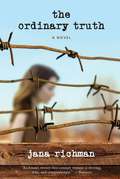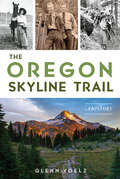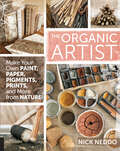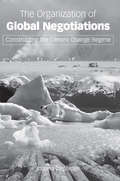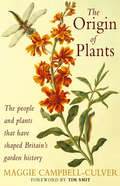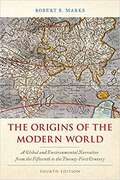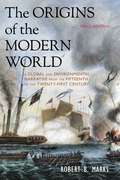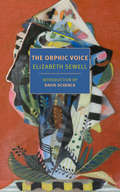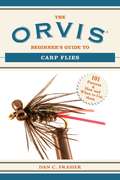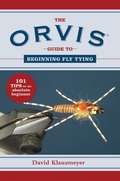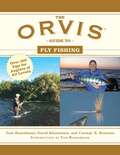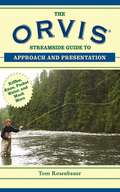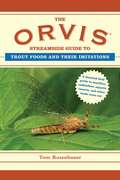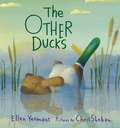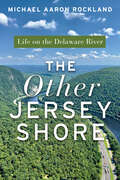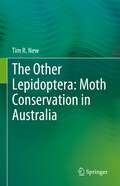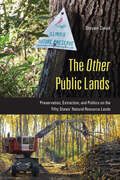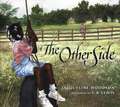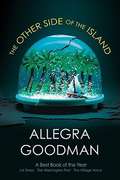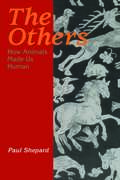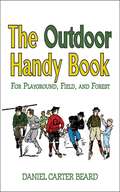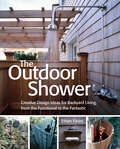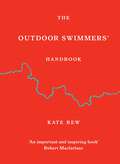- Table View
- List View
The Ordinary Truth
by Jana RichmanWhen Nell Jorgensen buried her husband, she buried a piece of herself-and more than one secret. Now, thirty-six years later, the rift between Nell and her daughter Kate threatens to implode as Kate, a water manager for the Nevada Water Authority, plans to pipe water from a huge aquifer that lies beneath the family ranch to thirsty Las Vegas. Meanwhile, Nell's granddaughter Cassie intends to unearth those old secrets and repair the resentments that grew in their place. Throughout the novel, sparse and beautiful landscapes surround an emotional wilderness of love, loss, and family.Jana Richman is the award-winning author of The Last Cowgirl (HarperCollins, 2009), a novel which won the 2009 Willa Award for Contemporary Fiction. A sixth-generation Utahn, Jana was born and raised in Utah's west desert, the daughter of a small-time rancher and a hand-wringing Mormon mother. With the exception of a few misguided years spent in New York City trying to make a fortune on Wall Street, she has lived her entire life west of the hundredth meridian. She writes about issues that threaten to destroy the essence of the west-and about passion, beauty, and love. Jana lives in Escalante, Utah.
The Oregon Skyline Trail: A History (The History Press)
by Glenn VoelzThe foundation of America's greatest long-distance hiking trail. The Skyline Trail began as a network of footpaths created by Oregon's indigenous tribes. Early fur traders and explorers followed in their steps, seeking safe routes over the unmapped Cascades. Judge John Breckenridge Waldo later spent decades exploring the mountain trail between Mount Hood and Crater Lake and led the campaign for the area's preservation. During the 1920s, the Forest Service briefly considered turning the path into a scenic highway and sent one of its first recreational specialists, Frederick Cleator, to blaze a prospective route through the mountains before scrapping the ideaJoin author Glenn Voelz as he recounts the fascinating history of Oregon's Skyline Trail.
The Oregon Trail
by Francis ParkmanThe author's journey brings the sight, sound and smell of the Great Plains of the mid-19th century, a dry, treeless land of wild grasses and sagebrush.
The Organic Artist: Make Your Own Paint, Paper, Pigments, Prints, and More from Nature
by Nick NeddoDrawing on ancient techniques, a primitive-arts instructor shows how to reconnect with nature by making and using your own all-natural art supplies.The Organic Artist encourages you to return to those days when art was made with all-natural materials, like charcoal and birch bark. Immersing you in the natural world, this book seeks to inspire creativity by connecting you to your organic roots.In addition to offering a wide variety of suggestions for using nature as supplies for art, this book also introduces the concepts of awareness and perception that are foundational to the creative process. You can refine your drawing skills, as well as increase their appreciation for the visual arts and the natural landscape. Projects and skills covered include:Making paper and wild inkWorking with soapstone, clay, wood, and rawhidePrintmaking and stencilingNatural pigments and dyesCamouflage and body paintingNature journaling, and more“Clear, concise and easy to follow . . . a pleasure to both use as a how-to book and read through.” —Michael Pewtherer, author of Wilderness Survival Handbook
The Organization of Global Negotiations: Constructing the Climate Change Regime
by Joanna DepledgeThe basic assumption of this book is that the organization of a negotiation process matters. The global negotiations on climate change involve over 180 countries and innumerable observers and other participants, addressing enormously complex and economically vital issues with conflicting agendas. For the UN to create an effective and well-supported international regime has required enormous and very skilful organization: factors such as the role of the Chair, the choice of negotiating arenas, the rules for the conduct of business and the approach of negotiating texts are usually taken for granted, and rarely attract attention until something goes wrong. This book explores how the negotiations were organized to produce the Kyoto Protocol to the Climate Change Convention and the subsequent Bonn Agreements and Marrakesh Accords. The author draws out the lessons and implications for other intricate and far-reaching negotiations, not all of which have succeeded so far, such as the WTO trade negotiations at Seattle and Cancun. This is essential reading for all participants in and organizers of international negotiations; and for researchers and students of international relations, climate change and environmental studies.
The Origin Of Plants: The People And Plants That Have Shaped Britain's Garden History
by Maggie Campbell-CulverA fascinating history of Britain's plant biodiversity and a unique account of how our garden landscape has been transformed over 1000 years, from 200 species of plant in the year 1000 to the astonishing variety of plants we can all see today. Thousands of plants have been introduced into Britain since 1066 by travellers, warriors, explorers and plant hunters - plants that we now take for granted such as rhododendron from the Far East, gladiolus from Africa and exotic plants like the monkey puzzle tree from Chile.Both a plant history and a useful reference book, Maggie Campbell-Culver has researched the provenance and often strange histories of many of the thousands of plants, exploring the quirky and sometimes rude nature of the plants, giving them a personality all of their own and setting them in their social context. The text is supported by beautiful contemporary paintings and modern photographs in 2 x 8 pp colour sections.
The Origins Of The Modern World: A Global And Environmental Narrative From The Fifteenth To The Twenty-first Century
by Robert B. MarksThe Origins of the Modern World: A Global and Environmental Narrative from the Fifteenth to the Twenty-First Century (World Social Change)
The Origins of the Modern World: A Global and Environmental Narrative
by Robert B. MarksThis clearly written and engrossing book presents a global narrative of the origins of the modern world from 1400 to the present. Unlike most studies, which assume that the rise of the West is the story of the coming of the modern world, this history, drawing upon new scholarship on Asia, Africa, and the New World and upon the maturing field of environmental history, constructs a story in which those parts of the world play major roles, including their impacts on the environment. Robert B. Marks defines the modern world as one marked by industry, the nation state, interstate warfare, a large and growing gap between the wealthiest and poorest parts of the world, increasing inequality within the wealthiest industrialized countries, and an escape from the environmental constraints of the biological old regime. He explains its origins by emphasizing contingencies (such as the conquest of the New World); the broad comparability of the most advanced regions in China, India, and Europe; the reasons why England was able to escape from common ecological constraints facing all of those regions by the eighteenth century; a conjuncture of human and natural forces that solidified a gap between the industrialized and non-industrialized parts of the world; and the mounting environmental crisis that defines the modern world. Now in a new edition that brings the saga of the modern world to the present in an environmental context, the book considers how and why the United States emerged as a world power in the twentieth century and became the sole superpower by the twenty-first century, and why the changed relationship of humans to the environmental likely will be the hallmark of the modern era the Anthropocene. Once again arguing that the U. S. rise to global hegemon was contingent, not inevitable, Marks also points to the resurgence of Asia and the vastly changed relationship of humans to the environment that may in the long run overshadow any political and economic milestones of the past hundred years.
The Orphic Voice: Poetry and Natural History
by Elizabeth SewellA wondrously written book of literary criticism and philosophy that maps the relationship between poetry and natural history, connecting verse from poets such as Shakespeare and Rainer Maria Rilke to the work of scientists and theorists like Francis Bacon and Michael Polanyi.Taking its bearings from the Greek myth of Orpheus, whose singing had the power to move the rocks and trees and to quiet the animals, Elizabeth Sewell&’s The Orphic Voice transforms our understanding of the relationship between mind and nature. Myth, Sewell argues, is not mere fable but an ancient and vital form of reflection that unites poetry, philosophy, and natural science: Shakespeare with Francis Bacon and Giambattista Vico; Wordsworth and Rilke with Michael Polanyi. All these members of the Orphic company share a common perception that &“discovery, in science and poetry, is a mythological situation in which the mind unites with a figure of its own devising as a means toward understanding the world.&” Sewell&’s visionary book, first published in 1960, presents brilliantly illuminating readings of A Midsummer Night&’s Dream and Rilke&’s Sonnets to Orpheus, among other masterpieces, while deepening our understanding not only of poetry and the history of ideas but of the biological reach of the mind.
The Orvis Beginner's Guide to Carp Flies: 101 Patterns & How and When to Use Them (Orvis Guides)
by Dan C. FrasierLearn tips and tricks for all new flies sure to catch carp!Carp are one of the most widely distributed and abundant fish in North America. Their prodigious size and habit of finning in shallow water make them appear to be easy fly-fishing targets. In reality, most anglers quickly discover that they are extremely difficult to hook on a fly. It takes years to discover how to catch them consistently. The reason? Carp can be very selective about what flies they will take.This book will help to short-circuit that learning curve. Carp's selectivity can be boiled down to diet. Understanding what they are eating allows the angler to choose and tie a fly that will produce. The Orvis Beginner's Guide to Carp Flies walks the flyfisherman through the steps of identifying the most likely food source, illustrating the best patterns that imitate that food, and discussing how to effectively present those flies. With detailed information on tying all of the important carp flies, this book eliminates months of trial and error in your fly selection.
The Orvis Guide to Beginning Fly Tying: 101 Tips for the Absolute Beginner (Orvis Guides)
by David KlausmeyerThis Orvis-endorsed guidebook-part of a continuing series that includes guidebooks on fly fishing basics and saltwater fly fishing-will give you all the tools you need to begin making your own flies. Learn how to read a fly recipe, choose the correct tools (including vises, bobbins, threaders, dubbing needles, and hair stackers), select the right materials (everything from dry fly saddles, threads, beads, and Krystal Flash, to hooks, wires, cements, and paints), and pick the best flies to tie first. Before you know it, you'll be tying such flies as the Wooly Bugger, Clouser minnow, beadhead soft hackle nymphs, Adams dry fly, and Hare's Ear nymph. You'll also get solid advice on how to set up a well-organized fly-tying area, so you can enjoy this fascinating craft in ease and comfort. Fly Tyer magazine editor David Klausmeyer shares his Five Golden Rules for tying better flies. Many books say they are for beginners but then quickly turn fly tying into a series of complicated finger calisthenics. The Orvis Guide to Beginning Fly Tying really is for the reader who has never made a fly. Catch fish with flies that you've tied on your own, and you'll get more enjoyment from the rich sport of fly fishing.
The Orvis Guide to Fly Fishing: More Than 300 Tips for Anglers of All Levels (Orvis Guides)
by David Klausmeyer Conway X. Bowman Tom RosenbauerIn this compendium of fly fishing from three of the most respected names in the sport, Tom Rosenbauer, David Klausmeyer, and Conway X. Bowman share all of their most successful fly-fishing secrets. With tips on fresh- and saltwater fly fishing and tying flies, this book will help readers become the best flyfishermen they can be. The chapters discuss a wide range of fly-fishing topics, including:Choosing the right equipment, such as rods, reels, fly lines, and wadersCasting under different conditionsHow to find and catch troutWhich tides are best for saltwater fly fishingEssential items to pack for a saltwater fly-fishing tripHow to prepare for emergency situationsTaking care of your tackleSelecting the right materials for tying fliesTying dry flies that ride higher and float longerAnd much moreNever has there been a more comprehensive guide to the fulfilling sport of fly fishing. To catch that trophy you've been waiting for, The Orvis Guide to Fly Fishing is the perfect companion on your next fly-fishing adventure.
The Orvis Streamside Guide to Approach and Presentation: Riffles, Runs, Pocket Water, and Much More (Orvis Guides)
by Tom RosenbauerI know how to cast, I know my knots, and I can tell a dry from a wet fly. What next? This pocket guide shows the fly fisher where to cast, why, and what kind of fly to use. It can be studied prior to a fishing trip or used in the water.Streamers, nymphs, wets, and dry flies are detailed with diagrams and color photographs. The book is organized by water types, and once you identify what kind of water you are facing—riffles, runs, pocket water, or deep slow water—you can then decide what kind of fly to use, what leader is appropriate, and how to present the fly. Chapters cover topics such as:How to enter a poolAngle and attitude of approachMidstream rocksHead, middle, and tail of a poolRiffles and runsEtiquetteAnd much more!No more days of returning without a catch. With the extensive experience and knowledge of author Tom Rosenbauer, you can use his no-nonsense tips to identify appropriate fly-fishing wet and dry flies, adapt to current water conditions, and cast with confidence.
The Orvis Streamside Guide to Trout Foods and Their Imitations (Orvis Guides)
by Tom RosenbauerEvery fly fisher would agree that knowing your mayflies from your stoneflies is strongly correlated with a successful day on the water. This knowledge is vital because, as author Tom Rosenbauer notes, trout are shy and careful and can be fussy about what they eat. In addition, they won't hesitate to swim away and leave a meal if they feel threatened.In The Orvis Streamside Guide to Trout Foods and Their Imitations, Rosenbauer explains how and when to use many types of trout foods, including aquatic insects, terrestrial insects, crustaceans, and more. Designed with both the novice and intermediate fly fisher in mind, Rosenbauer teaches readers how to:Ambush troutIdentify types of insectsPresent trout food properlyObserve what trout are eatingUse imitation trout foodsAnd moreWith The Orvis Streamside Guide to Trout Foods and Their Imitations at their sides, fly fishermen will be able to tell the difference between mayflies, stoneflies, caddisflies, midges, and a variety of other insects. In addition, they will also know when to use real foods and when to rely on the imitations in their tackle boxes.
The Other Ducks
by Ellen YeomansThis Duck and That Duck were the best of friends. They did everything together but sometimes two ducks just isn’t enough.When This Duck declares that he wishes there were Other Ducks around so they could waddle in a line (a very ducky thing to do), That Duck is quite confused.That is until This Duck and That Duck go swimming, look down, and finally meet The Other Ducks.Unfortunately, The Other Ducks never seem to come out of the water! Oh how This Duck and That Duck wish The Other Ducks would waddle outside the big puddle with them. But it’s getting colder and their feathers are starting to itch for warmer weather.Will these best friends ever find their companions? Join This Duck and That Duck in this witty and heartfelt tale as they discover the world around them.
The Other Jersey Shore: Life on the Delaware River
by Michael Aaron RocklandRiver otters, black bears, and red foxes drink from its clear waters. Prickly pear cacti grow from the red shale cliffs that overlook it, while on the river near Bordentown lies the archeological remnants of a sprawling estate built by the former King of Spain, Napoleon’s brother, who lived there for almost twenty years. You might imagine this magical and majestic waterway is located in some faraway land. But in fact, it’s the backbone and lifeblood of the Garden State: the Delaware River. The Other Jersey Shore takes readers on a personal tour of the New Jersey portion of the Delaware River and its surroundings. You will learn about the role that the river played in human history, including Washington’s four crossings of the Delaware during the Revolutionary War. And you will also learn about the ecological history of the river itself, once one of the most polluted waterways in the country and now one of the cleanest, providing drinking water for 17 million people. Michael Aaron Rockland, a long-time New Jersey resident, shows readers his very favorite spots along the Delaware, including the pristine waterfalls and wilderness in the Delaware Water Gap recreation area. Along the way, he shares engrossing stories and surprising facts about the river that literally defines western New Jersey.
The Other Lepidoptera: Moth Conservation in Australia
by Tim R. NewConservation interest in moths, by far the predominant components of Lepidoptera, lags far behind that for butterflies, for which conservation practice provides many well-established lessons for extension to their near relatives. The needs of moths are at least as great, but their greater richness and variety, and far poorer documentation of diversity and biology over much of the world contribute to this lack of attention. Australia’s rich moth fauna, largely endemic and of global interest, illustrates many of the problems of developing wider interest and support for moth conservation. Numerous species (perhaps half the total fauna) are undescribed, and many are ecological specialists in restricted and vulnerable environments over small parts of the continent. Establishing their conservation status and needs whilst accepting that foundation knowledge is highly incomplete and much species-focused conservation is impracticable provides complex problems in setting priorities, based largely on wider diversity and effective advocacy. Most Australian vegetation systems, from grassland to forest and from sea-level to alpine zones, have been eroded in extent and quality since European settlement, resulting in massive habitat changes for native insects and to leave fragmented (and commonly degraded) remnants in which moths and others may persist. Recent surveys continue to increase recorded moth richness, reveal local faunal peculiarities, and indicate how assemblage changes may mirror wider environmental changes. This book is an overview of advances in documenting and interpreting moth diversity and ecology, to show how information from better-studied moth faunas can help in planning conservation of Australia’s moths through measures such as understanding the moths themselves by increased surveys and study, the factors influencing their diversity and wellbeing, and how such threats may be countered through increased coordinated conservation interest, commitment and management.
The Other Public Lands: Preservation, Extraction, and Politics on the Fifty States' Natural Resource Lands
by Steven DavisFor most Americans, state lands are the most readily accessible type of public land; however, despite their ubiquity, they remain largely terra incognita. The Other Public Lands is a primer on state public lands and the political dynamics that underlie their management. Offering a wide-angle overview, Steven Davis focuses on how states prioritize competing claims related to conservation, resource development, tourism, recreation, and finances. The Other Public Lands looks at both differences and common patterns in state land management, including the structure of natural resource agencies. Davis examines the privatization and commercialization of state parks, and the tensions between recreation, revenue and the preservation of biodiversity and natural landscapes. He also raises issues about equity, access, appropriate development, and ecological health. Chapters review state forests, state wildlife management areas, and school trust lands. In addition, the roles of interest groups, the courts, and agency culture and behavior are compared and analyzed both between states and the federal government and between states with differing approaches to specific issues. As there has been a demand to transfer at least some federal lands to the states, The Other Public Lands concludes with an appraisal of whether states could handle this transfer and goes on to suggest ways to ensure adequate access in an era of increased demand.
The Other Side
by Jacqueline WoodsonClover wonders why a fence separates the black side of town from the white side. When Annie, a white girl from the other side, begins to sit on the fence, Clover grows more curious as to why the fence is there.
The Other Side of the Island
by Allegra GoodmanFrom New York Times bestselling author Allegra Goodman comes a post apocalyptic novel about love, loss, and the power of human choice. Honor and her parents have been reassigned to live on Island 365 in the Tranquil Sea. Life is peaceful there—the color of the sky is regulated by Earth Mother, a corporation that controls New Weather, and it almost never rains. Everyone fits into their rightful and predictable place. . . . Except Honor. She doesn’t fit in, but then she meets Helix, a boy with a big heart and a keen sense for the world around them. Slowly, Honor and Helix begin to uncover a terrible truth about life on the Island: Sooner or later, those who are unpredictable disappear . . . and they don’t ever come back. The Other Side of the Island has been named a Best Book of 2008 by the LA Times, Washington Post, and Village Voice. .
The Other Side of the Island
by Allegra GoodmanEarth Mother is always watching... And one brave girl is about to find out why.
The Others: How Animals Made Us Human
by Paul ShepardPaul Shepard has been one of the most brilliant and original thinkers in the field of human evolution and ecology for more than forty years. His thought-provoking ideas on the role of animals in human thought, dreams, personal identity, and other psychological and religious contexts have been presented in a series of seminal writings, including Thinking Animals, The Tender Carnivore and the Sacred Game, and now The Others, his most eloquent book to date.The Others is a fascinating and wide-ranging examination of how diverse cultures have thought about, reacted to, and interacted with animals. Shepard argues that humans evolved watching other animal species, participating in their world, suffering them as parasites, wearing their feathers and skins, and making tools of their bones and antlers. For millennia, we have communicated their significance by dancing, sculpting, performing, imaging, narrating, and thinking them. The human species cannot be fully itself without these others.Shepard considers animals as others in a world where otherness of all kinds is in danger, and in which otherness is essential to the discovery of the true self. We must understand what to make of our encounters with animals, because as we prosper they vanish, and ultimately our prosperity may amount to nothing without them.
The Outdoor Handy Book: For Playground, Field, and Forest
by Daniel Carter BeardIngenuity and self-reliance are valuable qualities in a boy or man," writes famed outdoorsman Daniel Carter Beard. And what better way to foster them than by working-or playing-with your hands? For fathers who want to build the model ships (or real boats!) they never knew how to build, and sons who want to build the ultimate snow fort, The Outdoor Handy Book is a perfect compendium of wisdom and mischief. In its pages are directions for flying paper dragons, stilt-walking, playing dozens of ball games, building doghouses, capturing butterflies and frogs, and much more. Fully illustrated, and replete with notes to make sure that your fun is varied, continuous, and instructional in every season of the year, The Outdoor Handy Book is great all-ages activities resource, whether you're at the workbench or communing with nature.
The Outdoor Shower: Creative design ideas for backyard living, from the functional to the fantastic
by Ethan FierroAn outdoor shower is one of summer’s greatest pleasures. Providing practical building instructions for a variety of designs that range from a simple showerhead on the side of a cottage to a freestanding structure enclosed in frosted glass, Ethan Fierro shows you how to build an outdoor shower that reflects your unique personality and style. With an eye toward keeping costs down and environmentally friendly construction practices, Fierro will inspire you to create the shower of your dreams.
The Outdoor Swimmers' Handbook
by Kate Rew'An important, inspiring book by someone that has encouraged million of people to experience the wonders and friendships of Britain's rivers, lakes and seas' ROBERT MACFARLANE'A treasured guide for anyone who wants to venture into rivers, estuaries, lakes and seas for a dip, a moonlit swim or a great adventure. I loved this book!' LYNNE COXCapturing the freewheeling spirit, community and wisdom that defines The Outdoor Swimming Society movement, founder Kate Rew reveals everything you need to know to explore rivers, lakes, seas and estuaries. Sharing tales of her own inspiring swims, Kate explores the rich and varied life of outdoor swimmers, from the physiology of cold to planning lazy hazy downstream swims. An exquisite guide for beginners and enthusiasts alike, The Outdoor Swimmers' Handbook will lead you to the shore and become your trusted companion for the adventures ahead.
